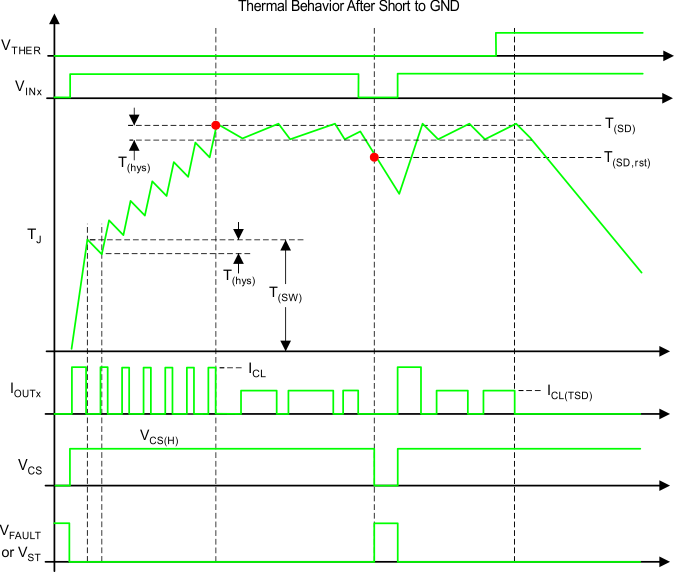JAJSEU4D December 2015 – December 2019 TPS4H160-Q1
PRODUCTION DATA.
- 1 特長
- 2 アプリケーション
- 3 概要
- 4 改訂履歴
- 5 概要(続き)
- 6 Device Comparison Table
- 7 Pin Configuration and Functions
- 8 Specifications
-
9 Detailed Description
- 9.1 Overview
- 9.2 Functional Block Diagram
- 9.3 Feature Description
- 9.4 Device Functional Modes
- 10Application and Implementation
- 11Power Supply Recommendations
- 12Layout
- 13デバイスおよびドキュメントのサポート
- 14メカニカル、パッケージ、および注文情報
パッケージ・オプション
メカニカル・データ(パッケージ|ピン)
- PWP|28
サーマルパッド・メカニカル・データ
- PWP|28
発注情報
9.3.6.5.1 Thermal Shutdown
Thermal shutdown is active when the absolute temperature TJ > T(SD). When thefrmal shutdown occurs, the respective output turns off. The THER pin is used to configure the behavior after the thermal shutdown occurs.
- When the THER pin is low, thermal shutdown operates in the auto-retry mode. The output automatically recovers when TJ < T(SD) – T(hys), but the current is limited to ICL(TSD) to avoid repetitive thermal shutdown. The thermal shutdown fault signal is cleared when TJ < T(SD,rst) or after toggling the related INx pin.
- When the THER pin is high, thermal shutdown operates in the latch mode. The output latches off when thermal shutdown occurs. When the THER pin goes from high to low, thermal shutdown changes to auto-retry mode. The thermal shutdown fault signal is cleared after toggling the related INx pin.
Thermal swing activates when the power FET temperature is increasing sharply, that is, when ΔT = T(FET) – T(Logic) > T(sw), then the output turns off. The output automatically recovers and the fault signal clears when ΔT = T(FET) – T(Logic) < T(sw) – T(hys). Thermal swing function improves the device reliability when subjected to repetitive fast thermal variation. As shown in Figure 30, multiple thermal swings are triggered before thermal shutdown occurs.
 Figure 30. Thermal Behavior Diagram
Figure 30. Thermal Behavior Diagram